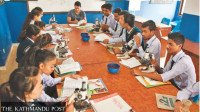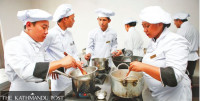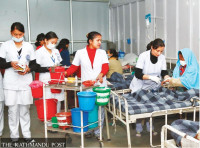Miscellaneous
Life in the huts
Pratima Ramtel was four years old when the earthquake destroyed her house on April 25 last year.
Dipesh Khatiwada
Pratima Ramtel was four years old when the earthquake destroyed her house on April 25 last year.
Since then, a temporary hut built by her grandparents is her “home”.
Pratima as a matter of fact got a new lease of life: she was rescued after an hour-long effort. She was trapped in her mud-and-stone house which had collapsed.
Pratima’s grandmother Nepti, 60, said Pratima and her five grandsons and granddaughters were in the house on that fateful day. Her grandfather Budhhiman, 58, is a carpenter by profession.
“All the kids except Pratima managed to get out of the house,” said Nepti. “It’s a miracle that we managed to pull her out of the rubble.”
Pratima is too small to remember the exact details, but what she is still scared of is the term “halliyo”, which means “it shook”.
Buddhiman has a few ropanis of land but it barely produces enough to feed eight mouths.
“What we had stored in our ‘bhakari’ (a traditional bamboo structure constructed for store grains) got mixed with the mud when the house collapsed,” said Budhhiman. “In the initial days of the earthquake, it was difficult for us to manage two square meals.”
Nepti said her husband, who barely earns enough to feed the family, does not have money to construct a house.
“We built two temporary huts near our ravaged house after the quake,” said Nepti. “With monsoon just round the corner, we are worried about our children.”
The plight of other households in the area is no different.
Kale Damai, 65, of Jaubari in Khari, said his family had no option than to live under a big tree after the quake.
“I have built a hut under the tree in my farmland,” said Damai. “The zinc sheets I had used to build the hut were blown away by a storm recently.”
Now, Damai and his wife have been forced to live under the open sky. “We spend the nights in a shed with the cattle.”
Damai and his son’s family received Rs 50,000 from the government to construct temporary huts and buy warm clothes during the winter. “But we could not invest the money to construct a hut or buy warm clothes, as we had to buy food to eat,” he said.
Life has been tough for villagers here.
According to the national census of 2011, there are 73,842 households in the district.
According to the District Disaster Management Committee (DDMC), over 80,000 households were affected by the quake.
Chief District Officer (CDO) Bishwo Prakash Subedi said the data of the quake affected households may differ as the engineers from the Central Bureau of Statistics (CBS) have been conducting fresh survey.
“The local body has already started to sign aid agreements on behalf of the government from Marpak VDC. If the government provides money on time, we might be able to distribute housing aid before monsoon,” said CDO Subedi.
But he added that he doubted if quake survivors would be able to build houses before monsoon.
And this is what scares Pratima and her grandparents the most.
“One more monsoon without a house? I don’t know how we are going to protect our children,” said Pratima’s grandmother Nepti.




 14.82°C Kathmandu
14.82°C Kathmandu










